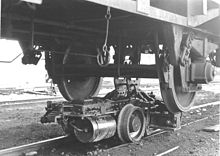
A bogie is a chassis or framework that carries a wheelset, attached to a vehicle—a modular subassembly of wheels and axles. Bogies take various forms in various modes of transport. A bogie may remain normally attached or be quickly detachable ; it may contain a suspension within it, or be solid and in turn be suspended ; it may be mounted on a swivel, as traditionally on a railway carriage or locomotive, additionally jointed and sprung, or held in place by other means.

Piggyback transportation refers to the transportation of goods where one transportation unit is carried on the back of something else. It is a specialised form of intermodal transportation and combined transport.

In rail transport, track gauge is the distance between the two rails of a railway track. All vehicles on a rail network must have wheelsets that are compatible with the track gauge. Since many different track gauges exist worldwide, gauge differences often present a barrier to wider operation on railway networks.
In railway engineering, "gauge" is the transverse distance between the inner surfaces of the heads of two rails, which for the vast majority of railway lines is the number of rails in place. However, it is sometimes necessary for track to carry railway vehicles with wheels matched to two different gauges. Such track is described as dual gauge – achieved either by addition of a third rail, if it will fit, or by two additional rails. Dual-gauge tracks are more expensive to configure with signals and sidings, and to maintain, than two separate single-gauge tracks. It is therefore usual to build dual-gauge or other multi-gauge tracks only when necessitated by lack of space or when tracks of two different gauges meet in marshalling yards or passenger stations. Dual-gauge tracks are by far the most common configuration, but triple-gauge tracks have been built in some situations.

The Selke Valley Railway (Selketalbahn), Gernrode-Harzgerode Railway and the Anhalt Harz Railway were different names for the metre gauge railway in the Lower Harz, Germany, originally owned by the Gernrode-Harzgerode Railway Company.
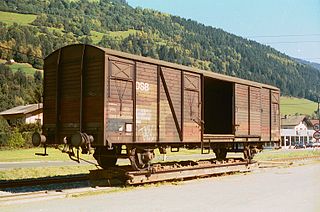
A transporter wagon, in railway terminology, is a wagon (UIC) or railroad car (US) designed to carry other railway equipment. Normally, it is used to transport equipment of a different rail gauge. In most cases, a transporter wagon is a narrower gauge wagon for transporting a wider gauge equipment, allowing freight in a wider gauge wagons to reach destinations on the narrower gauge network without the expense and time of transshipment into a narrower gauge wagons.

With railways, a break of gauge occurs where a line of one track gauge meets a line of a different gauge. Trains and rolling stock generally cannot run through without some form of conversion between gauges, leading to passengers having to change trains and freight requiring transloading or transshipping; this can add delays, costs, and inconvenience to travel on such a route.
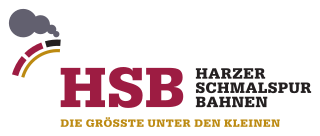
The Harz Narrow Gauge Railways is a railway company that operates a 1,000 mmmetre gauge network in the Harz mountains, in central Germany. The company was formed after the Second World War as a merger of two earlier companies. It owns about 140 kilometres of track, connecting the principal towns of Wernigerode, Nordhausen and Quedlinburg and several smaller settlements in the area. Much of the network is steeply graded and picturesque, but its most popular destination is the Brocken, the highest mountain in the region. The company runs a significant number of its trains with steam haulage, mostly employing 1950s vintage 2-10-2 tank locomotives, hauling traditional open-platform bogie carriages. The company is mainly owned by the various local authorities whose territories it serves.

A variable gauge system allows railway vehicles in a train to travel across a break of gauge between two railway networks with different track gauges.

The GT4 is an articulated tram vehicle built by Maschinenfabrik Esslingen from 1959 until 1965.

Germany has an extensive number of tramway networks. Some of these networks have been upgraded to light rail standards, called Stadtbahn in German. Straßenbahn and Stadtbahn schemes are usually operated on the legal foundation of the BOStrab, the Tramways Act of Germany.
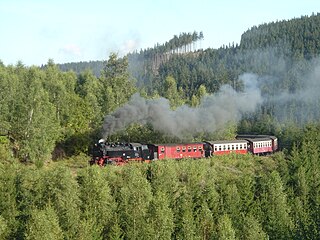
The Harz Railway or Trans-Harz Railway was formerly the main line of the Harz Narrow Gauge Railways and runs north to south right across the Harz Mountains from Wernigerode to Nordhausen. However, the tourist attraction of the Brocken, the highest mountain in the Harz, is so great that the Brocken Railway is effectively the main line today. The Trans-Harz Railway joins up with the Selke Valley Railway to Quedlinburg at Eisfelder Talmühle where all trains are organised to make good connections.

The Transports Publics Fribourgeois (TPF) is a renaming of the former Chemins de fer Fribourgeois Gruyère-Fribourg-Morat when the municipal Transport en commun de Fribourg (TF) was absorbed in 2000.
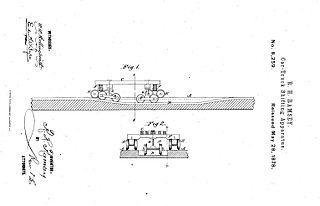
In railroad industry, the Ramsey car-transfer apparatus was a device to replace bogies on railroad cars to permit transfer of a train between railroad lines with different gauge.

Bogie exchange is a system for operating railway wagons on two or more gauges to overcome difference in the track gauge. To perform a bogie exchange, a car is converted from one gauge to another by removing the bogies or trucks, and installing a new bogie with differently spaced wheels. It is generally limited to wagons and carriages, though the bogies on diesel locomotives can be exchanged if enough time is available.

The Yverdon to Sainte-Croix Railway is a 1,000 mmmetre gauge railway line and former railway company in Switzerland. The line connects the towns of Yverdon-les-Bains and Sainte-Croix, both in the canton of Vaud, and is some 24 kilometres (15 mi) long, overcoming a vertical height change of 633 metres (2,077 ft). It is now owned and operated by the TRAVYS company.

Open wagons form a large group of railway goods wagons designed primarily for the transportation of bulk goods that are not moisture-retentive and can usually be tipped, dumped or shovelled. The International Union of Railways (UIC) distinguishes between ordinary wagons and special wagons (F/6). Open wagons often form a significant part of a railway company's goods wagon fleet; for example, forming just under 40% of the Deutsche Bahn's total goods wagon stock in Germany.
The Gauge War was a figurative war of intense competition to control new territory, waged between expanding railway companies in Great Britain in the nineteenth century. The contest for which track gauge should become the standard carried with it the greater struggle for which companies and stakeholders would win or lose in commerce, controlling or commercially dominating rights of way.

Flat wagons, as classified by the International Union of Railways (UIC), are railway goods wagons that have a flat, usually full-length, deck and little or no superstructure. By contrast, open wagons have high side and end walls and covered goods wagons have a fixed roof and sides. Flat wagons are often designed for the transportation of goods that are not weather-sensitive. Some flat wagons are able to be covered completely by tarpaulins or hoods and are therefore suitable for the transport of weather-sensitive goods. Unlike a "goods wagon with opening roof", the loading area of a flat is entirely open and accessible once the cover is removed.
Keith Archibald Smith, OBE, AM, MIE Aust, FCIT, was Chief Mechanical Engineer, and later Commissioner, for the Commonwealth Railways of Australia, which operates mostly in remote and desolate areas railways for the Federal Government.
